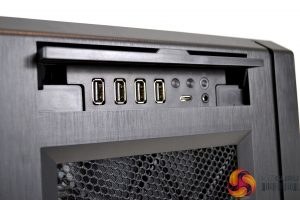Phanteks packages the Enthoo Pro II in a very inconspicuous plain-looking brown cardboard box, you would be forgiven for thinking this is just any ordinary PC case when looking at the box. However, inside things begin to look a little more premium with the case heavily protected with dense foam and black fabric material covering.
Inside the box along with the case is another small box that contains accessories. The accessory pack comprises of four modular 3.5-inch HDD brackets that can be installed to the case in various locations, a vertical GPU mount, GPU anti-sag bracket, a dual system cover, a toolbox that contains various screws and additional motherboard standoffs, a few zip-ties for cable management as well as a user manual and RMA information leaflet.
The front panel of the Enthoo Pro II is manufactured from plastic with a brushed effect finish and is equipped with a large mesh vent for optimal airflow. The outer mesh is a fabric with approximately 4mm holes, behind is a much tighter woven plastic mesh dust filter attached to the chassis via magnets.
Running vertically along the right-hand side and horizontally along the bottom of the front panel is a channel moulded into the plastic. At first glance I thought this could have been hiding some LED lighting, however, it is just there for aesthetic reasons and not serving any other purpose. Also at the bottom of the front panel is a Phanteks logo.
At the top of the front fascia is the front I/O panel hidden behind a flap that is hinged from the top. The front panel I/O consists of four USB 3.0 Type-A ports, a single USB 3.1 Gen 2 Type-C port, 3.5mm audio jacks for headphones and a microphone, as well as power/reset buttons and power/HDD activity LEDs. When installing a dual system inside the Enthoo Pro II, the reset button and HDD LED can be used as a power button and LED for the second system.
It is much of the same at the top of the case with a fine perforated metal mesh dust filter attached to the case via a flexible magnetic strip. Beneath the mesh is a mounting point for fans or radiators and a more open perforated metal vent, with a power button that combines a power LED towards the front of the top panel.
The left-hand side panel is typical of modern cases with a full tempered glass window, while the right-hand side panel is more traditional steel construction with a large airflow vent towards the front and smaller vent for the power supply at the rear.
Around the back of the Enthoo Pro II is the most interesting part of the exterior because it gives you a sneak preview of what can be built inside. Working from the top down, there is the usual cut-out for the motherboard rear I/O panel and a typical 120mm or 140mm fan/radiator mounting.
Below are eight horizontal PCIe slots, three vertical PCIe slots for thick graphics cards to be mounted vertically, and right at the bottom of the case is a vertically orientated power supply cut-out as well as another panel to the right with a removable section for installing a second power supply.
Alternatively, the whole right-hand panel can be detached from the case and the dual system cover that is supplied in the accessory pack can be installed in its place, to allow for the installation of a mini-ITX motherboard and a triple-slot graphics card to make up the second system, something that we will be attempting later during this review.
Finally, at the bottom of the case are four feet fitted with anti-vibration rubber pads that provide approximately 25mm of ground clearance for bottom airflow. The base of the case is also equipped with a full-length woven plastic mesh filter that can be removed from the front.
 KitGuru KitGuru.net – Tech News | Hardware News | Hardware Reviews | IOS | Mobile | Gaming | Graphics Cards
KitGuru KitGuru.net – Tech News | Hardware News | Hardware Reviews | IOS | Mobile | Gaming | Graphics Cards






















